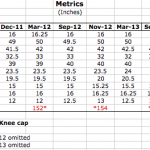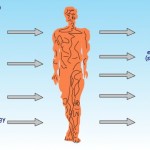

Building Muscle Slowlyby Brad PilonThis post was created simply because I was feeling sorry for myself this morning.I wasn’t making any gains. Lifting weights was stupid. All I was doing was maintaining – complete waste of my time.(Yes, I was being a baby)So I took my measurements… then compared them to all of my older measurements.At first, it looked like I had confirmed my suspicion – no growth ever! …But on further inspection I realized that I had been making slow but steady improvements all along.I then pulled out the records of my DEXA scans at plugged them into a new row…As you can see, I was mistaken – Slow but steady gains, slow but steady improvements in my circumferences.This is why we keep measurements – because without measurements we are just guessing. And weight on its own is a terrible way to measure progress… On each and every one of these measurement days I weighed somewhere between 170 and 180 pounds, but weight fluctuates so much it’s really not a valuable measurement tool unless it is accompanied by your circumference measurements.So lesson learned -Our eyes (and emotions) can deceive us… don’t trust them Over the last 3+ years with Eat Stop Eat, How Much Protein and Adonis Styled Workouts I’ve been slowly adding muscle 5 pounds of muscle makes a big difference. I’ve managed to keep my body fat levels fairly stable (as measured by DEXA and my waist circumference)
Link:



 For now classes are 6pm and 640pm at 2840 Wildwood st in the Boise Cloggers studio.
Book your class NOW!
click this ==>
For now classes are 6pm and 640pm at 2840 Wildwood st in the Boise Cloggers studio.
Book your class NOW!
click this ==>








